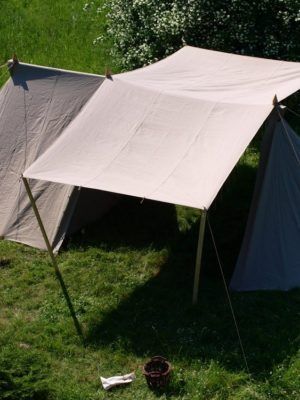Viking Tent – Oseberg – 3 m – Wool
1,350.00 €
Viking tent build on two triangles joined with three crossbars. Based on the findings from Oseberg in Norway. Thanks to it counstruction it can be set up without any pegs virtually on every kind of surface. However, long wooden elements are rather uncomfortable in transport. This model was popular during early Middle Ages, especially among Vikings. Dimensions: 2,5 m wide, 2,2 m high and nearly 3 m long.
Viking tent in so claled Oseberg style because it is based on findings from Norway. Especially in early middle ages tents were made of woolen fabric. Wool was available in many regions and have lot of adventages. That is why it was used for many purposes, no only clothes. This model was popular during early Middle Ages, especially among Vikings.
This type of Viking tent is build on two triangles joined with three crossbars. Thanks to it counstruction it can be set up without any pegs virtually on every kind of surface. However, long wooden elements are rather uncomfortable in transport. Dimensions of constructed Viking tent: 2,5 m wide, 2,2 m high and nearly 3 m long.
Because of that we do not deliver wooden planks and suggest makeing them on your own as delivery cost would be expensive. Of course we can make them as well and shipp if you want. Decorative carvings on wood for your Viking tent is also available.
This exact model of Oseberg tent is made in woolen cloth of weight 600g. Good quality fabric was treated with impregnate at factory. We do not make it on our own. Thanks to proffesional impregnation it will not soak through even during prolonged rain.
This fabric you will also find in our offer.
The set for this Viking tent includes:
- Tent canvas in one piece
- Tent pegs
- Transport bags
For practical advices and hints we recommend our Blog and chanel at YouTube.
Oseberg tent, woolen and other materials used in the past
Instead of relics (they are not preserved to our time) we have to interpret written sources and iconography, however it is only depicted their form. Very hard to interpret is a small piece of woolen textile with relic of rope. It could be part of sail or a woolen tent. Ibn-Fadlan in his relation (X century) had written about a tent on the Viking ship, unfortunately he did not write, which material it has been produced. But he wrote, that Nomads used leather made tents.
For later centuries we have more detailed sources and a lot of iconography. In chansons de geste the knights lived in silk tents. The same material we can found in Arabian lords and byzantine emperors tents. In Tower armory inventory (half of XIV century) we can read about woolen, linen and one cotton tents. A century later Charles the Bold (duke of Burgundy) had a velvet and silk tent.
The earlist total preserving tents in Europe are from early modern period. There are Charles V tent (half of XVI century) from Toledo Museum and XVII-century from Basel. Charles’ tent has been made of cotton and silk, but it is and Indian product.
| Weight | 30 kg |
|---|---|
| Dimensions | 100 × 40 × 30 cm |
| Inner walls | no, yes |
| Side and front rain curtains | no, yes |
| Hand forged steel pegs | no, yes |
| Storm ropes | no, yes |
You may also like…
- 460.00 € – 740.00 €Select options
- Select options
Saxon Tent / aka Norman – cotton – 3×6
780.00 € – 1,200.00 € - 1,900.00 € – 2,080.00 €Select options
- Select options
Conical Tent – 4m diameter – Linen
1,000.00 € – 1,210.00 € - Select options
Norman Tent / Saxon Tent – 3 x 6 – Linen
1,500.00 € – 2,450.00 € - Select options
Norman Style Tent – cotton – 4×8
1,120.00 € – 1,730.00 €












